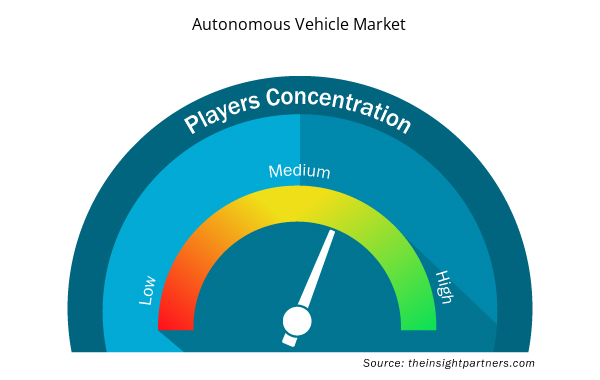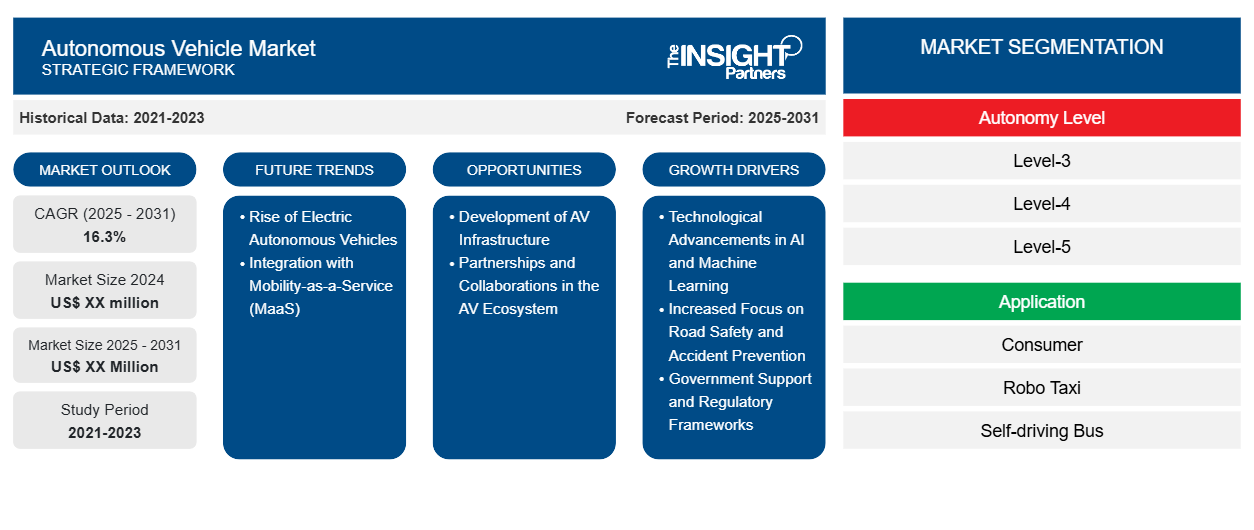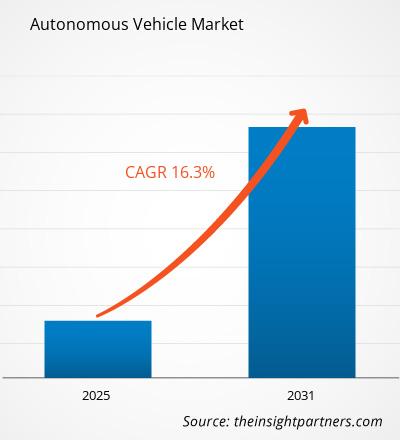من المتوقع أن يسجل سوق المركبات ذاتية القيادة معدل نمو سنوي مركب بنسبة 16.3٪ من عام 2023 إلى عام 2031، مع توسع حجم السوق من XX مليون دولار أمريكي في عام 2023 إلى XX مليون دولار أمريكي بحلول عام 2031.
تم تقسيم التقرير حسب مستوى الاستقلالية (المستوى 3، المستوى 4، المستوى 5)؛ التطبيق (المستهلك، سيارة الأجرة الآلية، الحافلة ذاتية القيادة، خدمة النقل الجماعي، خدمة مشاركة الركوب). تم تقسيم التحليل العالمي بشكل أكبر على المستوى الإقليمي والدول الرئيسية. يقدم التقرير القيمة بالدولار الأمريكي للتحليل والقطاعات المذكورة أعلاه.
غرض التقرير
يهدف تقرير سوق المركبات ذاتية القيادة الصادر عن The Insight Partners إلى وصف المشهد الحالي والنمو المستقبلي وأهم العوامل الدافعة والتحديات والفرص. وسيوفر هذا رؤى لمختلف أصحاب المصلحة في الأعمال التجارية، مثل:
- مزودي/مصنعي التكنولوجيا: لفهم ديناميكيات السوق المتطورة ومعرفة فرص النمو المحتملة، وتمكينهم من اتخاذ قرارات استراتيجية مستنيرة.
- المستثمرون: إجراء تحليل شامل للاتجاهات فيما يتعلق بمعدل نمو السوق، وتوقعات السوق المالية، والفرص المتاحة عبر سلسلة القيمة.
- الهيئات التنظيمية: لتنظيم السياسات ومراقبة الأنشطة في السوق بهدف تقليل الانتهاكات والحفاظ على ثقة المستثمرين ودعم سلامة السوق واستقرارها.
تجزئة سوق المركبات ذاتية القيادة
مستوى الاستقلال
- المستوى 3
- المستوى الرابع
- المستوى 5
طلب
- مستهلك
- روبوت تاكسي
- حافلة ذاتية القيادة
- ركوب البرد
- مشاركة الرحلة
قم بتخصيص هذا التقرير ليناسب متطلباتك
ستحصل على تخصيص لأي تقرير - مجانًا - بما في ذلك أجزاء من هذا التقرير، أو تحليل على مستوى الدولة، وحزمة بيانات Excel، بالإضافة إلى الاستفادة من العروض والخصومات الرائعة للشركات الناشئة والجامعات
- احصل على أهم اتجاهات السوق الرئيسية لهذا التقرير.ستتضمن هذه العينة المجانية تحليلاً للبيانات، بدءًا من اتجاهات السوق وحتى التقديرات والتوقعات.
محركات نمو سوق المركبات ذاتية القيادة
- التطورات التكنولوجية في الذكاء الاصطناعي والتعلم الآلي: إن التقدم المستمر في تقنيات الذكاء الاصطناعي والتعلم الآلي يقود سوق المركبات ذاتية القيادة. وتسمح هذه التطورات للمركبات ذاتية القيادة بمعالجة البيانات من أجهزة الاستشعار بشكل أفضل، واتخاذ القرارات في الوقت الفعلي، وتعزيز السلامة. كما يمكّن الذكاء الاصطناعي المركبات من تفسير بيئتها بدقة متزايدة، وتحسين الملاحة، وتجنب الاصطدام، وإدارة حركة المرور. ومع تطور هذه التقنيات، تزداد موثوقية السيارات ذاتية القيادة، مما يعزز ثقة المستهلك وقبوله، مما يسرع نمو السوق.
- التركيز المتزايد على السلامة على الطرق والوقاية من الحوادث: من المتوقع أن تعمل المركبات ذاتية القيادة على الحد من الأخطاء البشرية، والتي تعد مسؤولة عن غالبية حوادث المرور. من خلال الاستفادة من أجهزة الاستشعار والكاميرات والخوارزميات المتقدمة، يمكن للمركبات ذاتية القيادة توقع المخاطر والاستجابة بشكل أسرع من السائقين البشر. وقد استحوذ هذا الوعد بتقليل الحوادث بشكل كبير وإنقاذ الأرواح على اهتمام كل من الجهات التنظيمية والمستهلكين. تدعم الحكومات وشركات التأمين بشكل متزايد تكنولوجيا المركبات ذاتية القيادة لتحسين السلامة على الطرق، وبالتالي دفع نمو السوق.
- الدعم الحكومي والأطر التنظيمية: تستثمر الحكومات في جميع أنحاء العالم بكثافة في تقنيات المركبات ذاتية القيادة لتشكيل أنظمة النقل المستقبلية. ويتم تقديم سياسات ومنح وحوافز لتشجيع تطوير المركبات ذاتية القيادة واختبارها. بالإضافة إلى ذلك، تعمل الهيئات التنظيمية بنشاط على إنشاء أطر تضمن السلامة والأمن السيبراني والمعايير الأخلاقية للسيارات ذاتية القيادة. ويعمل هذا الدعم الحكومي، إلى جانب المبادئ التوجيهية التنظيمية الواضحة، على تعزيز ثقة السوق وتسريع نشر المركبات ذاتية القيادة على الطرق.
الاتجاهات المستقبلية لسوق المركبات ذاتية القيادة
- صعود المركبات الكهربائية ذاتية القيادة: إن التقارب بين تقنيات المركبات الكهربائية والمركبات ذاتية القيادة هو اتجاه ناشئ. وتتوافق المركبات الكهربائية التي تعمل بالطاقة النظيفة مع الدفع نحو الاستدامة والنقل الأخضر. ومع قيام شركات صناعة السيارات بتطوير أنظمة ذاتية القيادة للسيارات الكهربائية، فإن الطلب على السيارات الكهربائية ذاتية القيادة آخذ في الارتفاع. ويشجع هذا الاتجاه السياسات البيئية وتفضيل المستهلك للنقل الصديق للبيئة وكفاءة التكلفة المتزايدة للسيارات الكهربائية. ومن المتوقع أن يؤدي التحول نحو المركبات الكهربائية ذاتية القيادة إلى توسع كبير في السوق في السنوات القادمة.
- التكامل مع التنقل كخدمة (MaaS): هناك اتجاه آخر يشكل سوق المركبات ذاتية القيادة وهو التكامل المتزايد للمركبات ذاتية القيادة مع منصات التنقل كخدمة (MaaS). يفضل المستهلكون بشكل متزايد نماذج النقل المشتركة حسب الطلب، مما يقلل من ملكية السيارات ويستخدم المركبات ذاتية القيادة في خدمات النقل التشاركي وخدمات النقل المكوكية والاتصال بالميل الأخير. تجمع منصات التنقل كخدمة بين خيارات النقل، بما في ذلك السيارات ذاتية القيادة والحافلات والدراجات، في خدمة واحدة سلسة. يساهم هذا الاتجاه في توسيع نطاق المركبات ذاتية القيادة كجزء أساسي من نظام النقل الحضري.
فرص سوق المركبات ذاتية القيادة
- تطوير البنية التحتية للسيارات ذاتية القيادة: يوفر الدفع العالمي نحو المدن الذكية والبنية التحتية المتصلة فرصًا كبيرة للسيارات ذاتية القيادة. يمكن لأنظمة الطرق الذكية المزودة بأجهزة استشعار متقدمة وإدارة حركة المرور والاتصال بين المركبات والبنية التحتية (V2I) أن تعزز سلامة وكفاءة السيارات ذاتية القيادة. تخلق هذه التطورات بيئة مواتية لنشر السيارات ذاتية القيادة ويمكنها خفض التكاليف التشغيلية وتحسين الأداء والحد من الحوادث. مع استثمار الحكومات في البنية التحتية الذكية، فإن سوق السيارات ذاتية القيادة على استعداد للنمو السريع.
- الشراكات والتعاون في منظومة المركبات ذاتية القيادة: تمثل الشراكات الاستراتيجية بين مصنعي السيارات وشركات التكنولوجيا ومؤسسات البحث فرصة قيمة لتسريع ابتكار المركبات ذاتية القيادة. ويمكن للشركات في قطاعي السيارات والتكنولوجيا الاستفادة من خبرة بعضها البعض في مجال الذكاء الاصطناعي وأجهزة الاستشعار وتحليلات البيانات وتصميم المركبات. ويمكن للتعاون أن يدفع تطوير المركبات ذاتية القيادة الأكثر أمانًا وموثوقية وبأسعار معقولة. ويعمل هذا النهج التعاوني على تعزيز الابتكار وتسريع طرح المركبات ذاتية القيادة تجاريًا ومساعدة الشركات على تقاسم العبء المالي لتطوير المركبات ذاتية القيادة.
رؤى إقليمية حول سوق المركبات ذاتية القيادة
لقد قام المحللون في Insight Partners بشرح الاتجاهات والعوامل الإقليمية المؤثرة على سوق المركبات ذاتية القيادة طوال فترة التوقعات بشكل شامل. يناقش هذا القسم أيضًا قطاعات سوق المركبات ذاتية القيادة والجغرافيا في جميع أنحاء أمريكا الشمالية وأوروبا ومنطقة آسيا والمحيط الهادئ والشرق الأوسط وأفريقيا وأمريكا الجنوبية والوسطى.

- احصل على البيانات الإقليمية المحددة لسوق المركبات ذاتية القيادة
نطاق تقرير سوق المركبات ذاتية القيادة
| سمة التقرير | تفاصيل |
|---|---|
| حجم السوق في عام 2023 | XX مليون دولار أمريكي |
| حجم السوق بحلول عام 2031 | XX مليون دولار أمريكي |
| معدل النمو السنوي المركب العالمي (2023 - 2031) | 16.3% |
| البيانات التاريخية | 2021-2022 |
| فترة التنبؤ | 2024-2031 |
| القطاعات المغطاة | حسب مستوى الحكم الذاتي
|
| المناطق والدول المغطاة | أمريكا الشمالية
|
| قادة السوق وملفات تعريف الشركات الرئيسية |
|
كثافة اللاعبين في سوق المركبات ذاتية القيادة: فهم تأثيرها على ديناميكيات الأعمال
يشهد سوق المركبات ذاتية القيادة نموًا سريعًا، مدفوعًا بالطلب المتزايد من المستخدم النهائي بسبب عوامل مثل تفضيلات المستهلكين المتطورة والتقدم التكنولوجي والوعي المتزايد بفوائد المنتج. ومع ارتفاع الطلب، تعمل الشركات على توسيع عروضها والابتكار لتلبية احتياجات المستهلكين والاستفادة من الاتجاهات الناشئة، مما يؤدي إلى زيادة نمو السوق.
تشير كثافة اللاعبين في السوق إلى توزيع الشركات أو المؤسسات العاملة في سوق أو صناعة معينة. وهي تشير إلى عدد المنافسين (اللاعبين في السوق) الموجودين في مساحة سوق معينة نسبة إلى حجمها أو قيمتها السوقية الإجمالية.
الشركات الرئيسية العاملة في سوق المركبات ذاتية القيادة هي:
- شركة بي ام دبليو ايه جي
- شركة دايملر ايه جي
- شركة فورد للسيارات
- جنرال موتورز
- مجموعة SA
إخلاء المسؤولية : الشركات المذكورة أعلاه ليست مرتبة بأي ترتيب معين.

- احصل على نظرة عامة على أهم اللاعبين الرئيسيين في سوق المركبات ذاتية القيادة
نقاط البيع الرئيسية
- التغطية الشاملة: يغطي التقرير بشكل شامل تحليل المنتجات والخدمات والأنواع والمستخدمين النهائيين لسوق المركبات ذاتية القيادة، مما يوفر صورة شاملة.
- تحليل الخبراء: تم تجميع التقرير على أساس الفهم العميق لخبراء الصناعة والمحللين.
- معلومات محدثة: يضمن التقرير أهمية الأعمال التجارية بسبب تغطيته للمعلومات الحديثة واتجاهات البيانات.
- خيارات التخصيص: يمكن تخصيص هذا التقرير لتلبية متطلبات العملاء المحددة وبما يتناسب مع استراتيجيات العمل بشكل مناسب.
وبالتالي، يمكن أن يساعد تقرير البحث حول سوق المركبات ذاتية القيادة في تمهيد الطريق لفك شفرة وفهم سيناريو الصناعة وآفاق النمو. ورغم وجود بعض المخاوف المشروعة، فإن الفوائد الإجمالية لهذا التقرير تميل إلى التفوق على العيوب.
- التحليل التاريخي (سنتان)، السنة الأساسية، التوقعات (7 سنوات) مع معدل النمو السنوي المركب
- تحليل PEST و SWOT
- حجم السوق والقيمة / الحجم - عالميًا وإقليميًا وقطريًا
- الصناعة والمنافسة
- مجموعة بيانات Excel


- Electronic Signature Software Market
- Flexible Garden Hoses Market
- Artwork Management Software Market
- Sleep Apnea Diagnostics Market
- Nitrogenous Fertilizer Market
- Semiconductor Metrology and Inspection Market
- Hand Sanitizer Market
- Transdermal Drug Delivery System Market
- Health Economics and Outcome Research (HEOR) Services Market
- Foot Orthotic Insoles Market

Report Coverage
Revenue forecast, Company Analysis, Industry landscape, Growth factors, and Trends

Segment Covered
This text is related
to segments covered.

Regional Scope
North America, Europe, Asia Pacific, Middle East & Africa, South & Central America

Country Scope
This text is related
to country scope.
الأسئلة الشائعة
Some of the customization options available based on the request are an additional 3-5 company profiles and country-specific analysis of 3-5 countries of your choice. Customizations are to be requested/discussed before making final order confirmation, as our team would review the same and check the feasibility.
The report can be delivered in PDF/PPT format; we can also share excel dataset based on the request.
The leading players operating in the Autonomous Vehicle Market include BMW AG, Daimler AG, Ford Motor Company, General Motors, Groupe SA, Renault Nissan Mitsubishi alliance, Tesla Inc, Toyota Motor Corporation, Volkswagen Group
The Autonomous Vehicle Market is estimated to witness a CAGR of 16.3% from 2023 to 2031
Shift Towards Enhanced Safety Features is the key future trend of the Autonomous Vehicle Market
The major factors driving the Autonomous Vehicle Market are:Technological Advancements#Increasing Consumer Demand for Connectivity
The List of Companies
1. BMW AG
2. Daimler AG
3. Ford Motor Company
4. General Motors
5. Groupe SA
6. Renault-Nissan-Mitsubishi alliance
7. Tesla Inc.
8. Toyota Motor Corporation
9. Volkswagen Group
10. Volvo-Autoliv-Ericsson-Zenuity alliance
The Insight Partners performs research in 4 major stages: Data Collection & Secondary Research, Primary Research, Data Analysis and Data Triangulation & Final Review.
- Data Collection and Secondary Research:
As a market research and consulting firm operating from a decade, we have published and advised several client across the globe. First step for any study will start with an assessment of currently available data and insights from existing reports. Further, historical and current market information is collected from Investor Presentations, Annual Reports, SEC Filings, etc., and other information related to company’s performance and market positioning are gathered from Paid Databases (Factiva, Hoovers, and Reuters) and various other publications available in public domain.
Several associations trade associates, technical forums, institutes, societies and organization are accessed to gain technical as well as market related insights through their publications such as research papers, blogs and press releases related to the studies are referred to get cues about the market. Further, white papers, journals, magazines, and other news articles published in last 3 years are scrutinized and analyzed to understand the current market trends.
- Primary Research:
The primarily interview analysis comprise of data obtained from industry participants interview and answers to survey questions gathered by in-house primary team.
For primary research, interviews are conducted with industry experts/CEOs/Marketing Managers/VPs/Subject Matter Experts from both demand and supply side to get a 360-degree view of the market. The primary team conducts several interviews based on the complexity of the markets to understand the various market trends and dynamics which makes research more credible and precise.
A typical research interview fulfils the following functions:
- Provides first-hand information on the market size, market trends, growth trends, competitive landscape, and outlook
- Validates and strengthens in-house secondary research findings
- Develops the analysis team’s expertise and market understanding
Primary research involves email interactions and telephone interviews for each market, category, segment, and sub-segment across geographies. The participants who typically take part in such a process include, but are not limited to:
- Industry participants: VPs, business development managers, market intelligence managers and national sales managers
- Outside experts: Valuation experts, research analysts and key opinion leaders specializing in the electronics and semiconductor industry.
Below is the breakup of our primary respondents by company, designation, and region:

Once we receive the confirmation from primary research sources or primary respondents, we finalize the base year market estimation and forecast the data as per the macroeconomic and microeconomic factors assessed during data collection.
- Data Analysis:
Once data is validated through both secondary as well as primary respondents, we finalize the market estimations by hypothesis formulation and factor analysis at regional and country level.
- Macro-Economic Factor Analysis:
We analyse macroeconomic indicators such the gross domestic product (GDP), increase in the demand for goods and services across industries, technological advancement, regional economic growth, governmental policies, the influence of COVID-19, PEST analysis, and other aspects. This analysis aids in setting benchmarks for various nations/regions and approximating market splits. Additionally, the general trend of the aforementioned components aid in determining the market's development possibilities.
- Country Level Data:
Various factors that are especially aligned to the country are taken into account to determine the market size for a certain area and country, including the presence of vendors, such as headquarters and offices, the country's GDP, demand patterns, and industry growth. To comprehend the market dynamics for the nation, a number of growth variables, inhibitors, application areas, and current market trends are researched. The aforementioned elements aid in determining the country's overall market's growth potential.
- Company Profile:
The “Table of Contents” is formulated by listing and analyzing more than 25 - 30 companies operating in the market ecosystem across geographies. However, we profile only 10 companies as a standard practice in our syndicate reports. These 10 companies comprise leading, emerging, and regional players. Nonetheless, our analysis is not restricted to the 10 listed companies, we also analyze other companies present in the market to develop a holistic view and understand the prevailing trends. The “Company Profiles” section in the report covers key facts, business description, products & services, financial information, SWOT analysis, and key developments. The financial information presented is extracted from the annual reports and official documents of the publicly listed companies. Upon collecting the information for the sections of respective companies, we verify them via various primary sources and then compile the data in respective company profiles. The company level information helps us in deriving the base number as well as in forecasting the market size.
- Developing Base Number:
Aggregation of sales statistics (2020-2022) and macro-economic factor, and other secondary and primary research insights are utilized to arrive at base number and related market shares for 2022. The data gaps are identified in this step and relevant market data is analyzed, collected from paid primary interviews or databases. On finalizing the base year market size, forecasts are developed on the basis of macro-economic, industry and market growth factors and company level analysis.
- Data Triangulation and Final Review:
The market findings and base year market size calculations are validated from supply as well as demand side. Demand side validations are based on macro-economic factor analysis and benchmarks for respective regions and countries. In case of supply side validations, revenues of major companies are estimated (in case not available) based on industry benchmark, approximate number of employees, product portfolio, and primary interviews revenues are gathered. Further revenue from target product/service segment is assessed to avoid overshooting of market statistics. In case of heavy deviations between supply and demand side values, all thes steps are repeated to achieve synchronization.
We follow an iterative model, wherein we share our research findings with Subject Matter Experts (SME’s) and Key Opinion Leaders (KOLs) until consensus view of the market is not formulated – this model negates any drastic deviation in the opinions of experts. Only validated and universally acceptable research findings are quoted in our reports.
We have important check points that we use to validate our research findings – which we call – data triangulation, where we validate the information, we generate from secondary sources with primary interviews and then we re-validate with our internal data bases and Subject matter experts. This comprehensive model enables us to deliver high quality, reliable data in shortest possible time.


 احصل على عينة مجانية لهذا التقرير
احصل على عينة مجانية لهذا التقرير